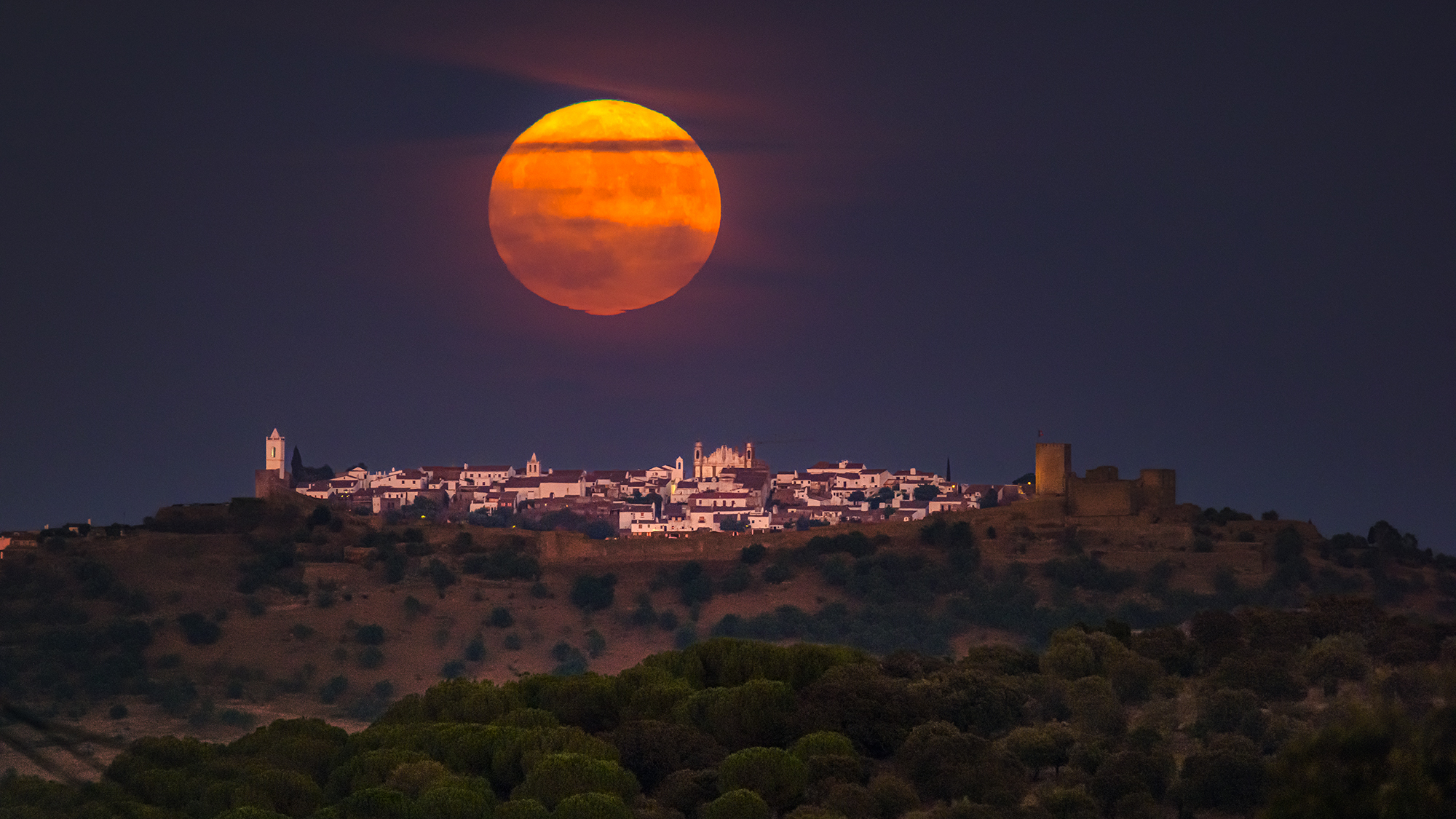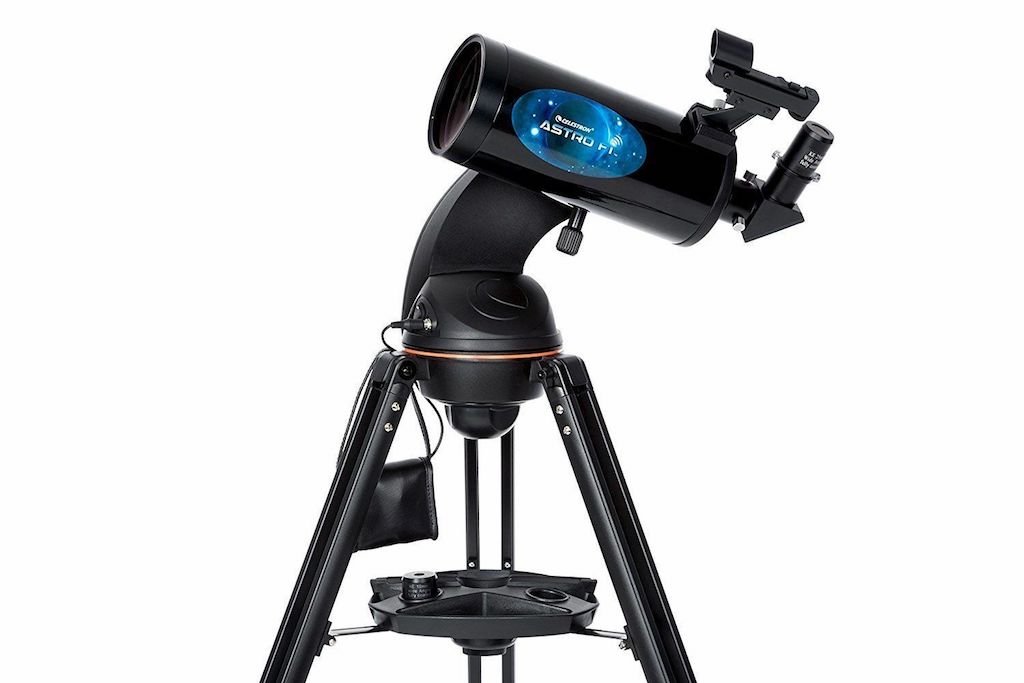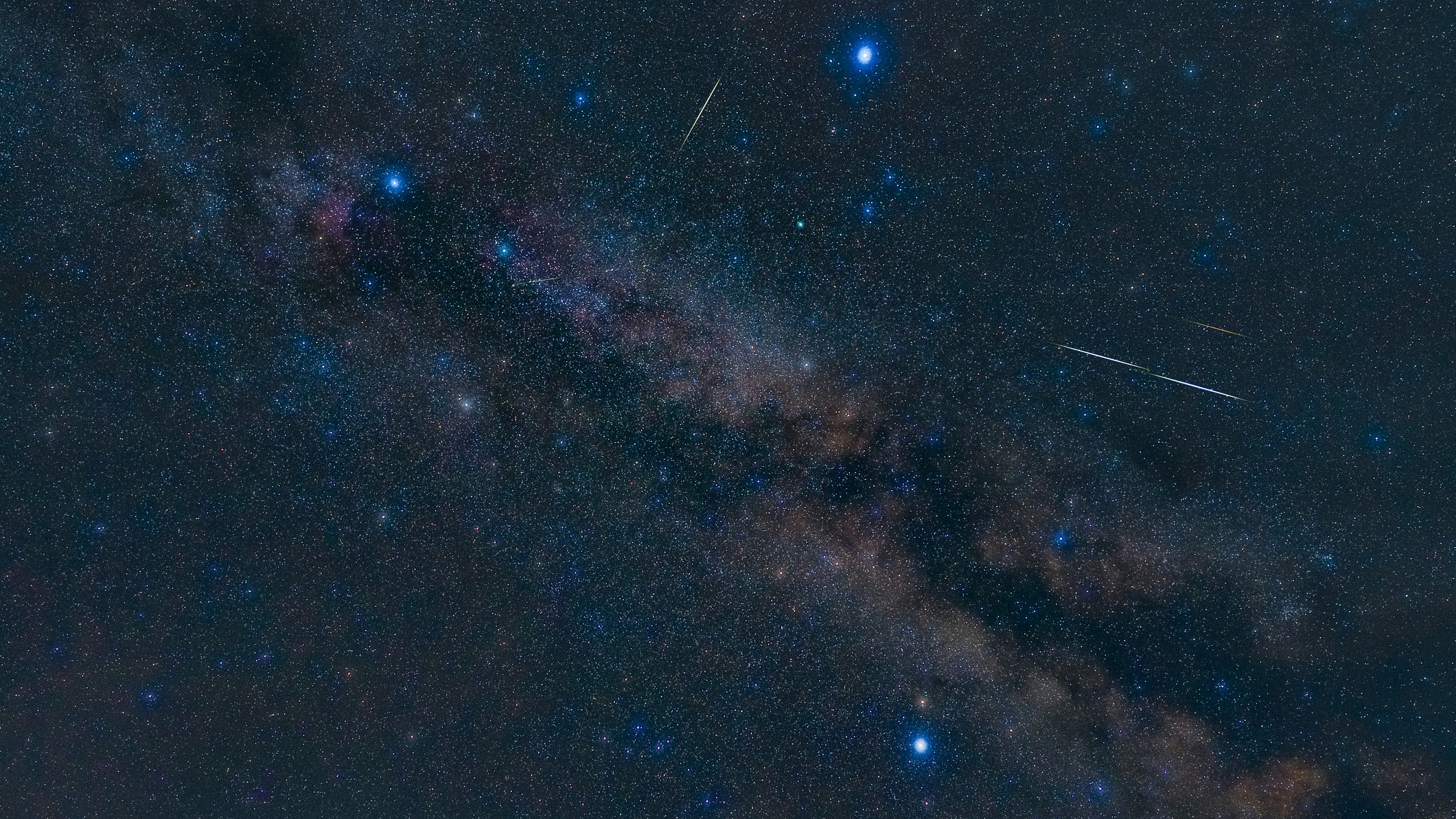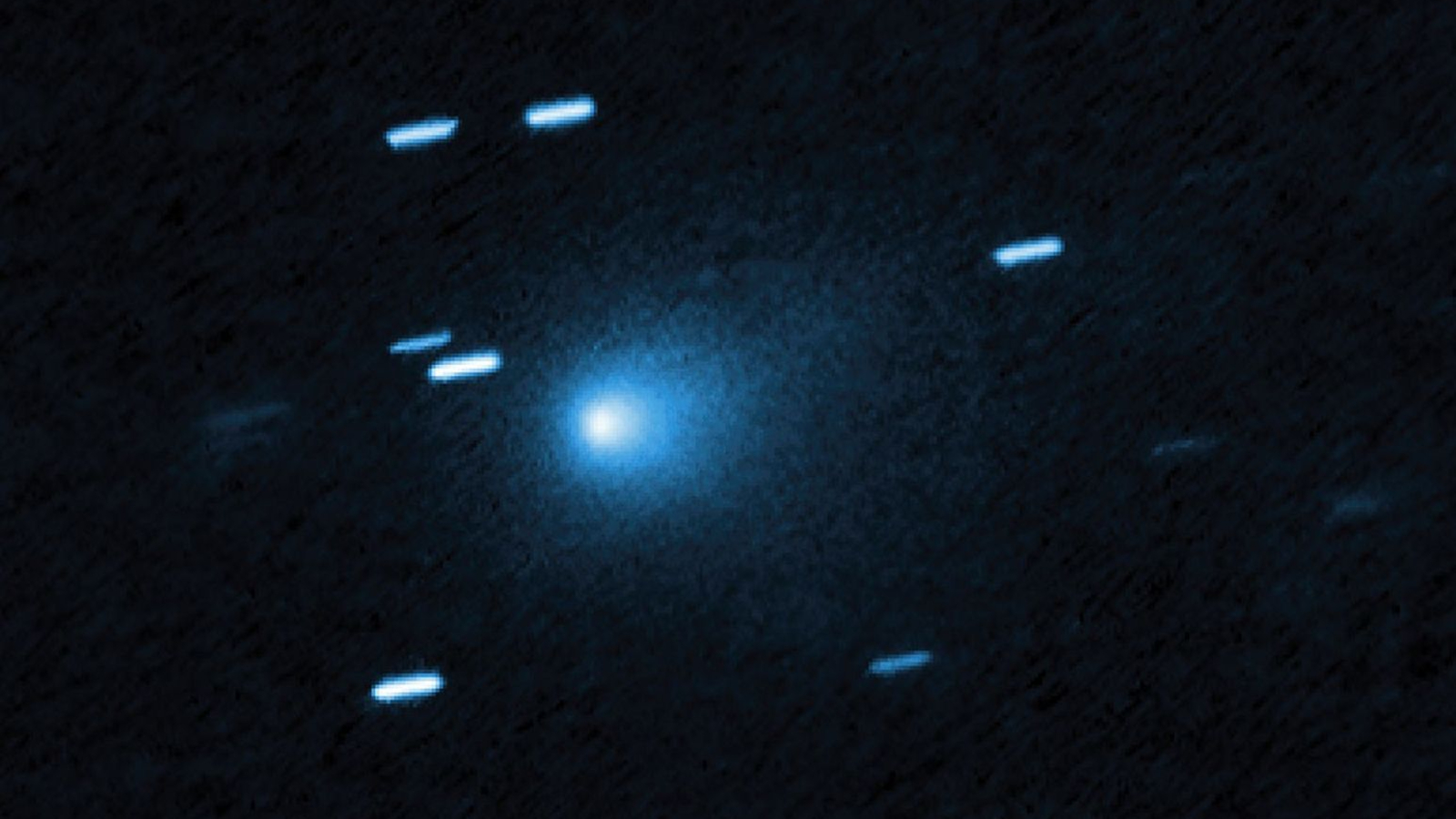October full moon 2025 guide: The Hunter's Moon follows close Saturn approach
The Hunter's Moon officially becomes full on Oct. 17 at 7:26 a.m. EDT (1126 GMT).

The full moon of October, called the Hunter's Moon, will grace the skies on Oct. 6 at 11:47 p.m. Eastern Daylight Time (0347 GMT), according to the U.S. Naval Observatory, a day after making a close approach to Saturn.
When we see a full moon, it is on the opposite side of the Earth from the sun; the two bodies are separated by 180 degrees. From Earth, we see the moon fully illuminated, reflecting the sun's light. If one were standing on the moon somewhere near the center of its disk as seen from Earth, the sun would be directly overhead.
The hour of the lunar phases is determined by time zone, so a full moon might happen during the day or at night. While on the Eastern Seaboard of the U.S. the full moon is at night, but in Tokyo, it is at 12:47 p.m. local time, the middle of the day.
In New York, the moon rises at 6:08 p.m. local time; sunset is at 6:29 p.m.; the sun and moon share the sky for twenty minutes; one can observe this with an unobstructed horizon. The nearly-full moon will often be in the sky at the same time as the sun for short periods; this is because the separation between the two hasn't reached the full 180 degrees yet. The moon sets at 7:30 a.m. on Oct. 7; as in the evening, the full moon and the sun are in the sky at the same time; sunrise is at 6:59 a.m.

Looking for a telescope to see the planets or the next skywatching event? We recommend the Celestron Astro Fi 102 as the top pick in our best beginner's telescope guide.
West of the Eastern Seaboard, the moon is full earlier in the evening; given that it is October and close to the equinox, moonrise tends to be at roughly similar times even as latitude changes. In Galveston, Texas, for example, the moon is full at 10:47 p.m. local time; moonrise is at 6:41 p.m. (sunset is at 6:59 p.m.).
Moving eastwards and towards the equator, in Singapore, moonrise is at 7:03 p.m. on Oct. 7, just after the full phase, which is at 11:47 a.m. local time. In Singapore, the sun sets at 6:55 p.m., so unlike the situation in the Western Hemisphere and further north or south, the sun and moon are not in the sky simultaneously.
In Cape Town, the full moon is at 5:57 a.m. Oct. 7; sunrise is at 6:15 a.m. and moonset is at 6:09 a.m.
Breaking space news, the latest updates on rocket launches, skywatching events and more!
Visible planets in October
The day before the moon is full, our satellite will make a close pass to the planet Saturn, called an appulse. The two bodies will reach conjunction, or the same celestial longitude, only a few minutes later. Observers in New York City will see the two closest to each other on October 5 at 7:59 p.m. EDT (2359 GMT), when they will be about 3 degrees apart, according to skywatching site in-the-sky.org. The moon and Saturn will be above the eastern horizon; Saturn will be below the moon about 21 degrees high.
From Chicago, where the appulse happens at 6:59 p.m. CDT, Saturn will be about 11 degrees high in the east with a near-full moon above it. The sun will be just below the horizon as it sets in Chicago that day at 6:22 p.m.
Further east, the conjunction happens later; in London, the moon is already in the western half of the sky when the close approach occurs at 12:59 a.m. local time; Saturn will be about 31 degrees high with the moon four degrees higher and to the right.
As one moves south the moon and Saturn will appear higher in the sky. From Miami, where, as in New York, the appulse is at 7:59 p.m., Saturn is about 21 degrees above the eastern horizon with the moon just above it and more to the left than from more northerly locales. From Quito, Ecuador, the appulse is at 6:59 p.m. and Saturn is 27 degrees high in the east, with the moon only slightly higher and to the right of the planet, in an almost-horizontal arrangement.
Once an observer is in the Southern Hemisphere, the apparent positions of the moon and Saturn look reversed; in Valparaiso, Chile, where the close approach is at 8:58 p.m. local time, the moon appears to be to the left and below Saturn; with Saturn 30 degrees above the northeastern horizon.
On the night of the full moon itself, October 6-7, from mid-northern latitudes, the moon will appear further to the left of Saturn in the evening after it rises. Looking east from New York City, for example, Saturn rises at 5:55 p.m. on Oct. 6, and will be at its highest (known as crossing the meridian, or transit) at 11:46 p.m.; at that point it is 46 degrees above the southern horizon. Saturn sets at 5:36 a.m. October 7.
After the moon and Saturn, the next planet to make an appearance is Jupiter, which rises after midnight at 12:09 a.m. on Oct. 7. It is in the constellation Gemini, among the bright stars that mark the coming winter in the Northern Hemisphere. The planet transits after sunrise at 7:30 a.m., so it will still be in the eastern half of the sky at dawn.
Venus is the last of the planets to make an appearance; it rises at 5:05 a.m. on Oct. 7, and sunrise follows at 6:59 a.m. Venus will still be relatively low in the sky, only 13 degrees high by about 6:15 a.m., but it is bright enough that it remains visible even as bright stars fade.
For Northern Hemisphere observers, Mars and Mercury are both above the horizon in the west at sunset, but too close to the sun to be visible.
As with the appulse of the moon and Saturn, moving further south puts the visible planets higher in the sky. In Miami, Saturn rises at 6:16 p.m. on Oct. 6, and crosses the meridian at 12:11 a.m. when it reaches an altitude of 61 degrees, about two-thirds of the way to the zenith. Jupiter rises at 1:10 a.m. Oct. 7, and will be 50 degrees high in the east by about 5 a.m. Venus clears the horizon at 5:37 a.m., at the start of civil twilight, and at 6:53 a.m., it is 16 degrees high in the east.
Nearer the equator, Saturn will be almost directly overhead. In Singapore, for example, the just-past-full moon appears below Saturn, which rises at 5:52 p.m. local time on October 7, during the day (sunset there is at 6:55 p.m.) By about 8 p.m., it is already 30 degrees high in the east; at the point where it crosses the meridian at 11:52 p.m., it is 85 degrees high. Saturn sets at 5:53 a.m. Oct. 8.
Jupiter rises at 1:34 a.m. Oct. 8, and is also substantially higher in the sky by 5 a.m. local time than it is in North America — 46 degrees high in the northeast.
In the Southern Hemisphere, some planets are actually lower in the sky than in the Northern Hemisphere and appear above the northern horizon as they transit. In Valparaiso, Chile, Saturn rises at 6:26 p.m. and transits at 12:26 a.m. (Oct. 7) when it Is 60 degrees above the northern horizon, similar to Miami. But Jupiter is lower in the sky than in the Northern Hemisphere. Jupiter rises at 3:18 a.m. local time, and is only 17 degrees high at 5 a.m. Venus is similarly more difficult to spot — Venus rises at 6:23 a.m., and sunrise is at 7:15 a.m.; by the time the sky is getting light at the start of civil twilight, Venus is only 5 degrees high.
Mars, on the other hand, which is basically invisible from the Northern Hemisphere, stays above the horizon just long enough to catch it after sunset; the planet sets at 9:56 p.m. and at 9 p.m. is still some 10 degrees above the western horizon.
October stars and constellations
In mid-northern latitudes — locations such as New York, Chicago, Sacramento or Madrid — by 9 p.m. local time, the sky is truly dark and the Summer Triangle is still visible, though it is in the western half of the sky. The Summer Triangle is an asterism consisting of Deneb, Vega and Altair, the brightest stars in Cygnus the Swan, Lyra the Lyre, and Aquila the Eagle, respectively. Deneb is the highest of the three stars; it will be almost directly overhead with Vega to the right of Deneb (westward). If one looks towards the horizon directly below Deneb, one finds Altair, the "eye" of the Eagle.
Looking above the moon, one can spot a large square of medium-bright stars, and this is the "Great Square," an asterism that is made up of three stars from Pegasus, the Winged Horse, and one that is the head of Andromeda, the daughter of Queen Cassiopeia and Cepheus, the king. The Square will appear to have one corner nearest the moon, with the left (eastern) corner being Andromeda's head.
Turning northwards, the Big Dipper will be quite close to the horizon and harder to see. However, if one looks left of the moon (northwards) one can see a bright "W" shape of stars about halfway to the zenith. This is Cassiopeia, Andromeda's mother. One can use Cassiopeia to find Polaris, the Pole Star, in Ursa Minor. While there are no "pointers" in Cassiopeia as there are in the Big Dipper, if one draws a rough line from the middle peak of the "W" to the left and downwards (at a near 45-degree angle between 9 p.m. and 10 p.m.), one will reach Polaris.
For Southern Hemisphere sky watchers, looking southeast at about 9 p.m. on Oct. 6 in Valparaiso, Chile, or Cape Town, South Africa, one can see Fomalhaut, to the right of and above Saturn at an altitude of 55 degrees; if one goes to the right and towards the southern horizon one sees Achernar, the alpha star of Eridanus the River, which winds across the sky all the way to near the feet of Orion.
Turning to the southwest, one will see the Southern Cross about 15 degrees high, with the longer leg of the cross pointing upwards from the horizon towards the southern celestial pole. Above the Cross, and to the right, are two bright stars. About a third of the way towards the zenith (30 degrees high) is Alpha Centauri, or Rigil Kentaurus, and about four degrees below it and slightly fainter is Hadar, or Beta Centauri.
Turning due west and looking at an altitude of about 40 degrees one can see Antares, the heart of an "upside down" Scorpius. The three stars of the claws are below Antares at this hour, and the Scorpion's body curves up from Antares to the left before going right again.
How the "Hunter's Moon" got its name
The October full moon is often called the Hunter's Moon, according to the Old Farmer's Almanac, because it happens when hunting for many game animals begins, a lot of hunting seasons even now are set in the autumn months, though it varies a lot by animal species and in the United States, local state laws.
Hunting, though, isn't the only association with the October lunation. According to the Ontario Native Literacy Coalition, the Anishinaabe people called October's full moon the "Mskawji Giizis," or the Freezing Moon, because October is when the first frosts occur in their traditional territory in the Great Lakes region. For traditional Chinese calendars, Oct. 6 is in the eighth lunar month, called Guìyuè or Osmanthus Month, as it is when those flowers tend to bloom. The October full moon is also the date of the Mid-Autumn Festival in China, which is celebrated with moon cakes and is traditionally a time to reunite with family. A similar moon-themed festival is celebrated from Oct. 6-9 in Japan, called Otsukimi, or "moon viewing." One aspect of celebrating the full moon was for people to gather where the moon could be seen and recite poetry.
In Jewish tradition, the October full moon will be the start of Sukkot, a holiday lasting seven days commemorating the Torah account of the Jewish people wandering the desert for 40 years after the escape from Egypt. Observant families will often build a temporary dwelling called a sukkah or to live in for the week-long holiday.

Jesse Emspak is a freelance journalist who has contributed to several publications, including Space.com, Scientific American, New Scientist, Smithsonian.com and Undark. He focuses on physics and cool technologies but has been known to write about the odder stories of human health and science as it relates to culture. Jesse has a Master of Arts from the University of California, Berkeley School of Journalism, and a Bachelor of Arts from the University of Rochester. Jesse spent years covering finance and cut his teeth at local newspapers, working local politics and police beats. Jesse likes to stay active and holds a fourth degree black belt in Karate, which just means he now knows how much he has to learn and the importance of good teaching.
You must confirm your public display name before commenting
Please logout and then login again, you will then be prompted to enter your display name.


